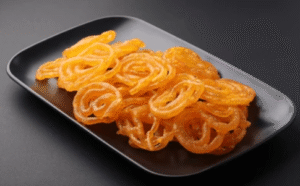Jalebi is a beloved sweet treat across South Asia and parts of the Middle East and North Africa. This dessert is made by deep-frying a fermented batter into circular or pretzel-like shapes, which are then soaked in sugar syrup, resulting in a crispy exterior and juicy interior.

Origins in the Middle East
The earliest known recipe for a dish resembling jalebi appears in the 10th-century Arabic cookbook Kitab al-Tabikh by Ibn Sayyar al-Warraq. This dish, known as zalabiya, was a deep-fried sweet soaked in syrup, popular in the Middle East. The term “jalebi” is believed to derive from the Arabic word zulabiya or the Persian zolbiya .
Introduction to the Indian Subcontinent
Jalebi made its way to the Indian subcontinent during the medieval period, likely introduced by Persian-speaking invaders. By the 15th century, references to jalebi appear in Indian literature. For instance, the Jain text Priyamkara-nrpa-katha, composed around 1450 CE, mentions jalebi in the context of a lavish dinner hosted by a wealthy merchant. Another Sanskrit work, Gunyagunabodhini, dating before 1600 CE, lists ingredients and a recipe for jalebi that closely resemble the modern version .
Evolution and Cultural Significance
Once introduced, jalebi was embraced and adapted across various regions of the Indian subcontinent. In India, it became a staple at festivals like Diwali and Ramadan, often enjoyed with accompaniments like rabri (sweet condensed milk) or curd. In Nepal, it’s known as jeri and commonly paired with swari, a thin fried bread, for breakfast. In Pakistan, jalebi is a popular dessert during winter, frequently consumed with warm milk .
Global Variations
Similar sweets exist in other cultures, reflecting the widespread appeal of this confection. In the Middle East and North Africa, variations like zlabia or zulbia are prevalent, especially during Ramadan. These versions often incorporate flavors like rose water or saffron. The American funnel cake is believed to have been inspired by these Middle Eastern treats, introduced by German immigrants .
Ingredients
For the Batter:
-
1 cup (125 grams) all-purpose flour (maida)
-
2 tablespoons gram flour (besan)
-
A pinch of baking soda
-
1/8 teaspoon turmeric powder (for natural coloring)
-
Water, as needed to make a thick, flowing batter.
For the Sugar Syrup:
-
1 cup sugar
-
1/2 cup water
-
1/4 teaspoon cardamom powder
-
A few strands of saffron (optional)
-
1/2 teaspoon lemon juice (to prevent crystallization)
Other:
-
Ghee or oil, for deep frying
👩🍳 Instructions
-
Prepare the Batter:
-
In a mixing bowl, combine all-purpose flour, gram flour, baking soda, and turmeric powder.
-
Gradually add water to form a thick, smooth batter. It should have a flowing consistency.
-
Cover and let the batter ferment in a warm place for 12–24 hours. This fermentation gives jalebi its characteristic tangy flavor.
-
Make the Sugar Syrup:
-
In a saucepan, combine sugar and water. Heat until the sugar dissolves completely.
-
Add cardamom powder and saffron strands. Boil the syrup until it reaches a one-string consistency.
-
Add lemon juice to prevent crystallization. Keep the syrup warm.
-
-
Fry the Jalebi:
-
Heat ghee or oil in a wide, flat-bottomed pan over medium heat. The oil should be moderately hot.
-
Pour the fermented batter into a piping bag or a squeeze bottle with a small nozzle.
-
Squeeze the batter into the hot oil in spiral or concentric circle shapes.
-
Fry until the jalebis turn golden and crisp on both sides.
-
-
Soak in Sugar Syrup:
-
Remove the fried jalebis from the oil and immediately immerse them in the warm sugar syrup.
-
Let them soak for about 2–3 minutes, ensuring they absorb the syrup well.
-
Remove and place them on a plate.
-
-
Serve:
-
Serve the jalebis warm or at room temperature. They pair wonderfully with rabri (sweet condensed milk) or can be enjoyed on their own.
-
